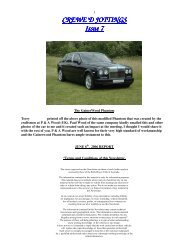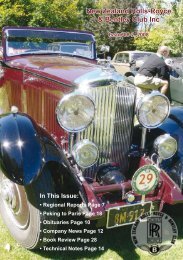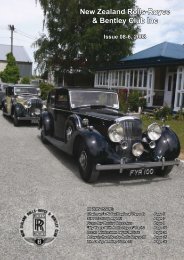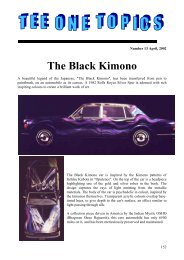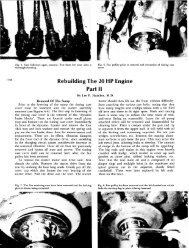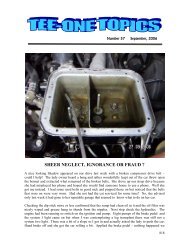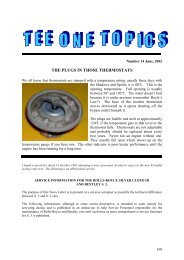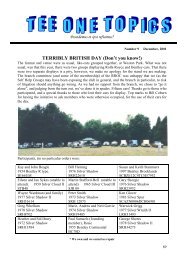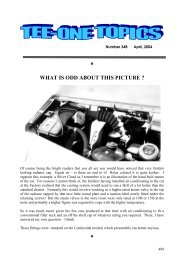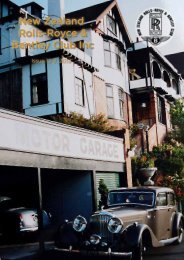New Zealand Rolls-Royce & Bentley Club Inc - KDA132
New Zealand Rolls-Royce & Bentley Club Inc - KDA132
New Zealand Rolls-Royce & Bentley Club Inc - KDA132
Create successful ePaper yourself
Turn your PDF publications into a flip-book with our unique Google optimized e-Paper software.
farm cottage.<br />
Extremely active in local body affairs Ernie was, for many years,<br />
a lodge secretary, a member of the local power board, county<br />
council, and hospital board, chairman of school and war memorial<br />
committees, a newspaper correspondent, and chair and honorary<br />
life member of the Hawkes Bay Automobile Association. He was<br />
predeceased by his wife and passed away in 1972.<br />
The Carlyon family and Gwavas<br />
When Mr A.S.G. Carlyon died his son, Captain E.T.R. Carlyon,<br />
and his daughter, later Mrs H Hudson inherited the station. Captain<br />
Carlyon died during World War Two.<br />
Gwavas Station remains an operational sheep and cattle farm,<br />
albeit significantly reduced in size from the original, and continues<br />
to be owned and managed by the Hudson family.<br />
Michael Hudson (grandson of A.S.G. Carlyon) and his wife,<br />
Caroline, live in the rebuilt original farm cottage homestead on the<br />
farm home block and remain firmly committed to the management<br />
and welfare of the 9 hectare historic and internationally renowned<br />
woodland home garden.<br />
Michael and Caroline’s daughter Phyllida, and her husband<br />
Stuart Gibson, brought family life back to the grand old 1889<br />
home in 2008, the first time the house had been occupied since<br />
1963. There has been major restoration to convert the homestead<br />
into a historic and exclusive dinner, bed and breakfast venue, and<br />
those who may be interested in living a little history can obtain<br />
details at info@gwavasgarden.co.nz<br />
The Carlyons’ second <strong>Rolls</strong>-<strong>Royce</strong><br />
A.S.G. Carlyon’s second <strong>Rolls</strong>-<strong>Royce</strong>, the 1922 Silver Ghost,<br />
has for many years been situated at Les Lemmon’s museum at<br />
Puketiritiri in Hawkes Bay.<br />
Acknowledgements<br />
The <strong>New</strong> <strong>Zealand</strong> Motor and Cycle Journal 25 th June 1912<br />
Tikokino – A History 1855-1990 by Sally Butler and Judy<br />
Matthews<br />
The Napier Daily Telegraph of 26 th August 1967<br />
The RROC (USA) Directory<br />
The <strong>Rolls</strong>-<strong>Royce</strong> Alpine Compendium published 1973<br />
Roy Tilley, Technical Liaison Officer, NZ <strong>Rolls</strong>-<strong>Royce</strong> & <strong>Bentley</strong><br />
<strong>Club</strong><br />
Cynthia and Mike Sierra, Odessa, Florida USA<br />
The Hudson and Gibson families of Gwavas Station<br />
Heather Smith and Pamela Young of Taradale, Hawkes Bay<br />
ROLLS-ROYCE 20HP, 20/25,<br />
25/30 & WRAITH<br />
In Detail 1922-1939<br />
By Nick Walker<br />
ISBN 978-1-906133-12-2<br />
Published by Herridge & Sons Ltd,<br />
Lower Forda, Shebbear,<br />
Beaworthy, Devon EX21 5SY in<br />
2009<br />
Hard bound 27.5 by 22 cm, 174<br />
pages, 100 colour and 160 blackand-white<br />
illustrations.<br />
$99.50 from Fazazz, 84 Lichfield St,<br />
Christchurch, (03) 365-5206 www.fazazz.co.nz<br />
This is the sixteenth book in Herridge’s “In Detail” series, and Nick<br />
Walker’s fourth, following his Alvis Speed Models; Aston Martin<br />
DB2, DB2/4 & DB3; and <strong>Bentley</strong> 3½ & 4¼ Litre (reviewed in our<br />
09-6). Sadly, it is Nick Walker’s last book, for he died in April<br />
this year, after a distinguished career as engineer, army officer,<br />
management consultant, librarian, and author of ten books including<br />
Coachwork on Vintage <strong>Bentley</strong>s (Herridge 2006).<br />
This reviewer warmed to the book immediately, for the cover<br />
features David and Kay Webster’s 1933 20/25 Rippon Brothers<br />
Sports Saloon GSY73, in which the generous owners gave local<br />
club members rides during the 20/25 Register Tour here early last<br />
year; it featured on the cover of our 09-2, and on Page 19 here.<br />
Walker takes us through the social circumstances which <strong>Royce</strong><br />
foresaw would prevail in the turmoil caused by The Great War, and<br />
the Company’s solution in the form of the 20 h.p. In its initial form<br />
it came in for criticism from both writers and readers of the motoring<br />
press; with a central change lever for its three-speed gearbox, and<br />
two-wheel brakes, it attracted such gibes as “the whole specification<br />
has an American flavour.” With a chassis price of £1,100 it was far<br />
removed from such cars as the Essex with a similar specification,<br />
but the Company’s extraordinary powers of development saw the<br />
basic design concept and some measurements of the 20 h.p. engine<br />
provide the basis for all the “small” engines for forty years, right up<br />
to the end of Silver Cloud I production in 1959.<br />
Continental testing by Works drivers, and even some trusted<br />
clients, took place in seven “Goshawk” cars entailing 41,000 miles<br />
Book Review<br />
on the shattered post-War French roads in poor weather. Each car<br />
built underwent a 150 mile test, and had to achieve 52 b.h.p. at the<br />
wheels; Walker points out that inspection and testing accounted for<br />
one third of all labour costs. Despite little publicity and no Motor<br />
Show appearance for the first eighteen months of production, a figure<br />
of 2,940 20 h.p. cars in seven years is remarkable, about four times<br />
that of the Lanchester 21 h.p., a car considered a worthy competitor.<br />
More remarkable still is the 42% survival rate of 20 h.p. cars, and<br />
there is no doubt that, when fitted with a body no heavier than the<br />
recommended 250 kilograms, this is a delightful vintage touring<br />
car. As development capability around aero engine and Phantom I<br />
design work became available, front brakes and four speed gear-box<br />
were introduced, initially at additional cost, but probably to absorb<br />
any backlog of chassis built.<br />
The Company made a great proportion of the car, and even when<br />
the S.U. carburettor replaced the <strong>Rolls</strong>-<strong>Royce</strong> design, this was built<br />
“in house.” Customers’ and coachbuilders’ ideas meant that the cars<br />
put on weight, and so we come to the 20/25 by August 1929, with a<br />
bigger cylinder bore of 82.6mm giving 3½ litres. The usual 10,000<br />
mile testing regime in France, virtually around the clock, applied.<br />
The Company was always sensitive to its competitors’ cars such as<br />
Sunbeam, Buick, and Lorraine-Dietrich, while Hudson Terraplanes<br />
and Studebakers provided performance at least the <strong>Rolls</strong>-<strong>Royce</strong>’s<br />
equal, but for only about £385, less than one quarter of the “standard”<br />
Park Ward saloon price. About 4,000 of these fine cars were built,<br />
the design being constantly revised with modified valve timing and<br />
size, raised compression ratio, and increased wheelbase.<br />
So we come to the 25/30 of 4¼ litres, of which 1201 were built in<br />
two and a half years, and then the Wraith, which had a quite different<br />
cruciform chassis with independent front suspension similar to the<br />
Phantom III and the engine mounted further forward, so that the<br />
purity of appearance, with the radiator in line with the front axle,<br />
was lost forever.<br />
Nick Walker concludes this most worthwhile addition to the<br />
Essential Book Shelf with chapters “On the Road Then” and “On<br />
the Road Now,” and this reviewer considers the “Then” chapter<br />
to be difficult, as we are transported back half a world, several<br />
generations and social classes to try and listen to our much more<br />
wealthy great-grandparents.<br />
A.T.K.<br />
NZRR&BC Issue 10-5 13



